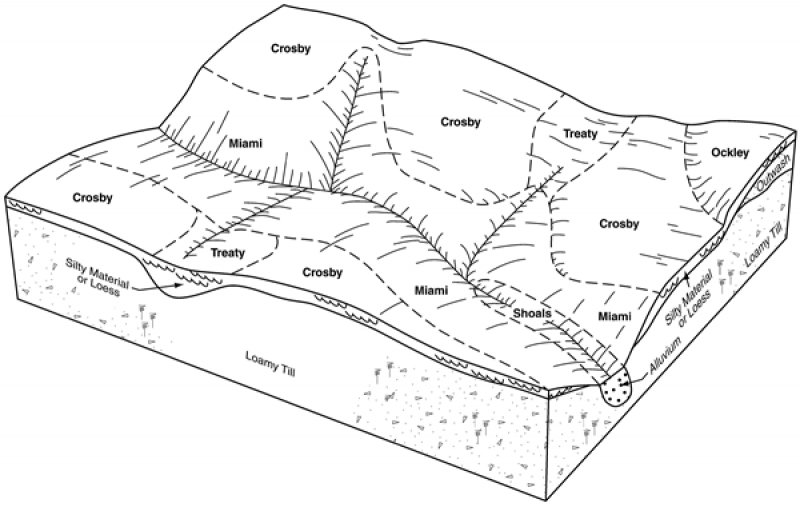
Natural Resources
Conservation Service
Ecological site F111XC007IN
Glacial Ridge
Last updated: 9/11/2024
Accessed: 12/22/2025
General information
Provisional. A provisional ecological site description has undergone quality control and quality assurance review. It contains a working state and transition model and enough information to identify the ecological site.
MLRA notes
Major Land Resource Area (MLRA): 111X–Indiana and Ohio Till Plain
A PROVISIONAL ECOLOGICAL SITE is a conceptual grouping of soil map unit components within a Major Land Resource Area (MLRA) based on the similarities in response to management. Although there may be wide variability in the productivity of the soils grouped into a Provisional Site, the soil vegetation interactions as expressed in the State and Transition Model are similar and the management actions required to achieve objectives, whether maintaining the existing ecological state or managing for an alternative state, are similar. Provisional Sites are likely to be refined into more precise group during the process of meeting the APPROVED ECOLOGICAL SITE DESCRIPTION criteria.
This PROVISIONAL ECOLOGICAL SITE has been developed to meet the standards established in the National Ecological Site Handbook. The information associated with this ecological site does not meet the Approved Ecological Site Description Standard, but it has been through a Quality Control and Quality Assurance processes to assure consistency and completeness. Further investigations, reviews and correlations are necessary before it becomes an Approved Ecological Site Description.
111C – Indiana and Ohio Till Plain, Northwestern Part. This MLRA is in the glaciated part of north-central Indiana and is dominated by glacial till plains broken in places by lake plains, outwash plains, and flood plains. Areas that parallel most of the major rivers and streams have deposits of sand.
Although it is an important agricultural region, MLRA 111C hosts a large proportion of Indiana’s biodiversity.
Classification relationships
Major Land Resource Area (MLRA)(USDA-Natural Resources Conservation Service, 2006)
USFS Ecological Regions (USDA, 2007):
Sections - Central Till Plains, Beech Maple (222H), South Central Great Lakes (222J), Central Till Plains and Grand Prairies (251D)
Subsections - Kalamazoo-Elkhart Moraines and Plains (222Jh), Steuben Interlobate Moraines (222Ji), Bluffton Till Plains (222Ha), Entrenched Valleys (222Hf), Miami-Scioto Plain-Tipton Till Plain (222Hb), Kankakee Sands (251Dg) and Eastern Grand Prairie (251Dd).
NatureServe Systems anticipated (NatureServe, 2011): Agriculture-Pasture/Hay, Agriculture-Cultivated Crops and Irrigated Agriculture, Harvested Forest-Grass Regeneration, Harvested Forest-Herbaceous Regeneration, Introduced Upland Vegetation – Treed, Managed Tree Plantation, North-Central Interior Beech-Maple Forest, North-Central Interior Dry Oak Forest & Woodland, North-Central Interior Dry-Mesic Oak Forest & Woodland, North-Central Interior Maple-Basswood Forest, North-Central Interior Oak Savanna, Ruderal Forest, Ruderal Upland-Old Field.
LANDFIRE Biophysical Settings anticipated (USGS, 2010): North-Central Interior Oak Savanna, North-Central Interior Dry-Mesic Oak Forest and Woodland, North-Central Interior Dry Oak Forest and Woodland, North-Central Interior Beech-Maple Forest, North-Central Interior Maple-Basswood Forest, South-Central Interior Mesophytic Forest.
Ecological site concept
This site is an upland site formed on glacial till parent materials. It is located on summits, shoulders and backslopes on relatively steep angles of slope (< 4%) with moderately well to well drainage. There are 4 distinct states: 1. till mesic woodland (reference state), 2. woodland state, 3. agriculture state, 4. old field state. The disturbance regime was characterized by low-severity surface fires. Most of these fires on this site were of set by Native Americans or overrun from fires on adjacent prairies and savannas. Fire frequency was a large determinant of the species dominance in the tree canopy.
Currently, roughly 60% of this site in in agricultural production, with the majority being used for corn and soybean production.
Associated sites
| F111XC015IN |
Dry Floodplain |
|---|---|
| R111XC005IN |
Glacial Depression |
| R111XC006IN |
Flat Glacial Ridge |
| R111XC010IN |
Well Drained Overflow |
| F111XC009IN |
Overflow |
Similar sites
| F111XC003IN |
Sandy Interdune |
|---|---|
| F111XC009IN |
Overflow |
Table 1. Dominant plant species
| Tree |
(1) Quercus alba |
|---|---|
| Shrub |
(1) Asimina triloba |
| Herbaceous |
(1) Cystopteris |
Click on box and path labels to scroll to the respective text.
